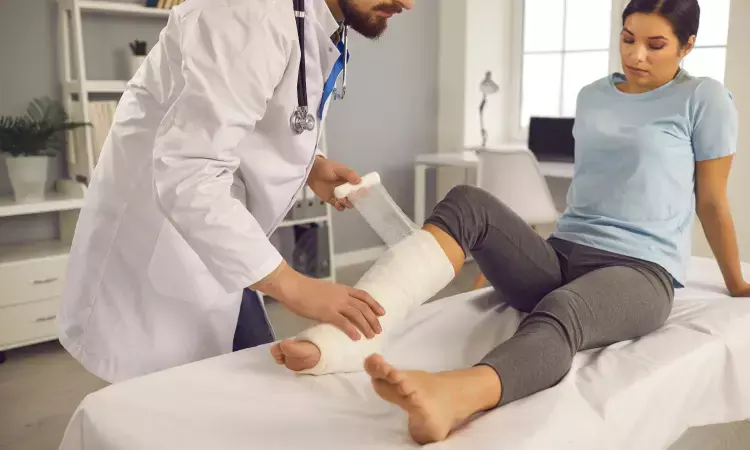- Home
- Medical news & Guidelines
- Anesthesiology
- Cardiology and CTVS
- Critical Care
- Dentistry
- Dermatology
- Diabetes and Endocrinology
- ENT
- Gastroenterology
- Medicine
- Nephrology
- Neurology
- Obstretics-Gynaecology
- Oncology
- Ophthalmology
- Orthopaedics
- Pediatrics-Neonatology
- Psychiatry
- Pulmonology
- Radiology
- Surgery
- Urology
- Laboratory Medicine
- Diet
- Nursing
- Paramedical
- Physiotherapy
- Health news
- Fact Check
- Bone Health Fact Check
- Brain Health Fact Check
- Cancer Related Fact Check
- Child Care Fact Check
- Dental and oral health fact check
- Diabetes and metabolic health fact check
- Diet and Nutrition Fact Check
- Eye and ENT Care Fact Check
- Fitness fact check
- Gut health fact check
- Heart health fact check
- Kidney health fact check
- Medical education fact check
- Men's health fact check
- Respiratory fact check
- Skin and hair care fact check
- Vaccine and Immunization fact check
- Women's health fact check
- AYUSH
- State News
- Andaman and Nicobar Islands
- Andhra Pradesh
- Arunachal Pradesh
- Assam
- Bihar
- Chandigarh
- Chattisgarh
- Dadra and Nagar Haveli
- Daman and Diu
- Delhi
- Goa
- Gujarat
- Haryana
- Himachal Pradesh
- Jammu & Kashmir
- Jharkhand
- Karnataka
- Kerala
- Ladakh
- Lakshadweep
- Madhya Pradesh
- Maharashtra
- Manipur
- Meghalaya
- Mizoram
- Nagaland
- Odisha
- Puducherry
- Punjab
- Rajasthan
- Sikkim
- Tamil Nadu
- Telangana
- Tripura
- Uttar Pradesh
- Uttrakhand
- West Bengal
- Medical Education
- Industry
Dual plating provides better coronal alignment in femoral periprosthetic fracture cases

The use of dual implants for treating distal femur periprosthetic fractures is a topic that has gained increasing attention. Dual plating (DP) has become an emerging approach for managing these complex and challenging injuries.
In their recent study, Andring et al. and colleagues concluded that dual plating for distal femoral periprosthetic fractures ensures good coronal alignment and low reoperation rates even in patients with immediate weight bearing. The patients regained baseline level of ambulation more reliably when compared to those treated with a single distal femoral locking plate.
This study is published in the Journal of Orthopaedic Trauma.
The present study described an experience with the DP construct. The study design and settings included a retrospective case series with a comparison group and a Level 1 academic trauma centre.
The selection criteria for patients in this study involved adults over 50 with sustaining comminuted OTA/AO 33-A2 or 33-A3 DFPF fractures. These cases were treated with either DP or a single distal femur locking plating (DFLP). Patients with simple 33-A1 fractures were not included in the study. Before 2018, DFLP was the preferred treatment and patients were treated with this method, but DP has become the treatment choice since then. The Outcome Measures and Comparisons included reoperation rate, alignment, and complications.
The results from this study are:
- Thirty-four patients treated with DFLP and 38 with DP met inclusion and follow-up criteria.
- The average follow-up duration in DFLP and DP groups was 18.2 ± 13.8 months and 19.8 ± 16.1 months, respectively.
- The average patient age in the DFLP and DP groups was 74.8 ± 7.3 years and 75.9 ± 11.3 years, respectively.
- No difference was reported in demographics, fracture morphology, loss of reduction, or reoperation for any cause.
- Compared to DFLP patients, DP patients were more likely to be weight-bearing in the twelve-week postoperative period and return to their baseline ambulatory status.
Dual plating of distal femoral periprosthetic fractures maintained coronal alignment and low reoperation rates even with immediate weight bearing. Patients regained ambulation (baseline level) more reliably than those treated with a single femoral locking plate. The LEVEL OF EVIDENCE was Therapeutic Level III.
Reference:
Andring et al. Dual Plate Fixation of Periprosthetic Distal Femur Fractures. Journal of Orthopaedic Trauma 38(1):p 36-41, January 2024
BDS, MDS in Periodontics and Implantology
Dr. Aditi Yadav is a BDS, MDS in Periodontics and Implantology. She has a clinical experience of 5 years as a laser dental surgeon. She also has a Diploma in clinical research and pharmacovigilance and is a Certified data scientist. She is currently working as a content developer in e-health services. Dr. Yadav has a keen interest in Medical Journalism and is actively involved in Medical Research writing.
Dr Kamal Kant Kohli-MBBS, DTCD- a chest specialist with more than 30 years of practice and a flair for writing clinical articles, Dr Kamal Kant Kohli joined Medical Dialogues as a Chief Editor of Medical News. Besides writing articles, as an editor, he proofreads and verifies all the medical content published on Medical Dialogues including those coming from journals, studies,medical conferences,guidelines etc. Email: drkohli@medicaldialogues.in. Contact no. 011-43720751


